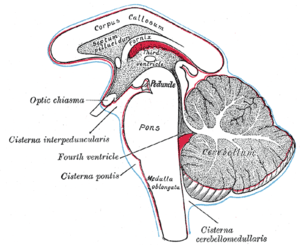Cisterna magna
The cisterna magna (or cerebellomedullaris cistern) is one of three principal openings in the subarachnoid space between the arachnoid and pia mater layers of the meninges surrounding the brain. The openings are collectively referred to as the subarachnoid cisterns. The cisterna magna is located between the cerebellum and the dorsal surface of the medulla oblongata. Cerebrospinal fluid produced in the fourth ventricle drains into the cisterna magna via the lateral apertures and median aperture.
| Cisterna magna | |
|---|---|
 Diagram showing the positions of the three principal cisterns in the brain. The cisterna magna is labelled as cisterna cerebellomedullaris at the lower right. | |
| Details | |
| System | Ventricular |
| Identifiers | |
| Latin | Cisterna magna, cerebellomedullary cistern |
| MeSH | D002946 |
| TA | A14.1.01.208 |
| FMA | 83721 |
| Anatomical terms of neuroanatomy | |
The two other principal cisterns are the pontine cistern located between the pons and the medulla and the interpeduncular cistern located between the cerebral peduncles.
While the most commonly used clinical method for obtaining cerebrospinal fluid is a lumbar puncture,[1] puncture of the cisterna magna may be performed in rare instances.[2]
References
- Boon, J.M.; Abrahams, P.H.; Meiring, J.H.; Welch, T. (2004). "Lumbar puncture: Anatomical review of a clinical skill". Clinical Anatomy. 17 (7): 544–53. doi:10.1002/ca.10250. PMID 15376294.
- Ward, E; Orrison, W. W.; Watridge, C. B. (1989). "Anatomic evaluation of cisternal puncture". Neurosurgery. 25 (3): 412–5. doi:10.1227/00006123-198909000-00015. PMID 2771012.